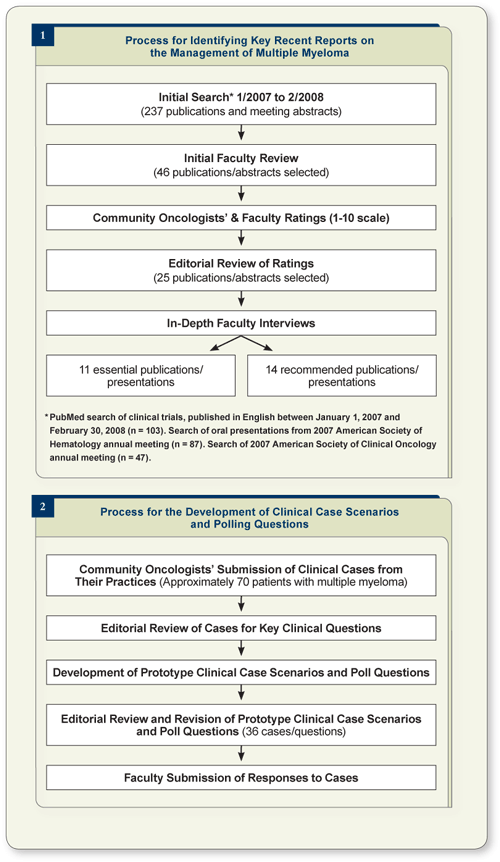

Medical oncologists and hematologists face a continuous barrage of clinical research reports spanning a spectrum of different cancers. Our education group’s committed content team of oncology clinicians knows this firsthand and spends its days and nights trying to stay on top of what’s going on in more than two dozen tumor types. It’s quite understandable that we spend a larger portion of that time focused on breast, colon and lung cancer — which make up at least two thirds of oncology practice — but in the last year alone we dove headfirst into the clinical and translational data in thyroid cancer, GIST, head and neck, ovary, renal cell, HCC and malignant glioma in order to produce in-depth education programs on these important topics.
 |
| Charles M Farber, MD, PhD |
Similarly, this slide set/monograph is our first major foray into multiple myeloma (MM). The need for effective CME in this unique cancer increased considerably after the recent data explosion at the December 2007 American Society of Hematology Annual Meeting, where no fewer than six Phase III randomized trials in MM were presented.
Realizing that this marked a true turning point in the management of this disease, we wanted to create a super-practical resource that clinicians could use to quickly yet effectively obtain the bottom line on what all this newly emerging research in MM really means to clinical practice.
To do this, our clinical team identified more than 230 2007-08 MM abstracts, manuscripts, presentations and review articles from major publications such as JCO, the New England Journal, Blood, The Lancet and important scientific meetings including ASCO and ASH. We then enlisted the help of a stellar faculty of four highly knowledgeable myeloma mavens with superb teaching skills and an eye toward what’s important. We asked them to take a look at our list and hone it down.
After several rounds of review, we arrived at a collection of 46 key publications, which we then sent to a select group of 23 practicing oncologists who agreed to consult with us on this project, including Dr Chuck Farber, a practicing doc who was previously on the faculty at Memorial Sloan-Kettering and worked closely with us as a gown-to-town liaison.
The community docs had previously worked with us on our Meet The Professors audio series, and we knew them to be highly knowledgable clinicians. They were given the important task of rating each article (on a 1-to-10 scale) for relevance and applicability to their practices. Based on the aggregated ratings, we eliminated the bottom half of the list, leaving us with 25 publications. We then posed two more challenges to these individuals:
With both faculty and practicing doc input, we reached a consensus that the 11 papers/ presentations referred to in Figure 1 were required understanding for any doc caring for a patient with MM. My informal vote for paper of the year is Cavo’s stunning ASH presentation of a Phase III evaluation of VTD.
A close runner-up is Rajkumar’s ECOG study on lenalidomide with high- and low-dose dex, followed by faculty member Paul Richardson’s ASH data set on Rev/Vel/Dex. We then conducted in-depth interviews with the four faculty members about the papers and then combined their edited comments with supporting graphics to create the slides contained in this monograph.
Simultaneously, we analyzed all the submitted cases and from them developed 36 multiple-choice case scenarios that address the clinical questions that were most important to our community oncologist panel, and we asked our faculty to tell us how they would likely manage such a case currently. If it all sounds rather complex and nightmarish to implement, well....in a way, it was, except that the traffic cop for this electronic mayhem was our supremely talented faculty relations coordinator, Melissa Vives — an unflappable, profoundly organized human being who in a sweet, very gentle but highly insistent way, cannot be ignored when she asks for work returned on time.
When the dust settled, we had somehow been able to boil down one year’s worth of clinical research in MM to approximately 137 data slides and 36 related case-based question slides that can be paired with keypad polling devices to facilitate interactive Q&A during live events. Our hope is that oncology clinicians will use this monograph and the PowerPoint slides contained on the enclosed CD for their own education or during lectures on this important subject. As in many areas of cancer medicine, biologic agents are revolutionizing clinical management of MM, and just in the past year, major research findings have had a clear-cut impact on treatment algorithms in practice.
We are hopeful that as more data emerge on an annual basis, we will be able to revisit this process to document for busy clinicians the most important developments in the field and provide an efficient review of the potential benefits of these advances to patients struggling with this disease.
— Neil Love, MD
DrNeilLove@ResearchToPractice.com

| FACULTY | |
 |
 |
| Andrzej J Jakubowiak, MD, PhD | Robert Z Orlowski, MD, PhD |
 |
 |
| Sagar Lonial, MD | Paul G Richardson, MD |
| Table of Contents | Top of Page |